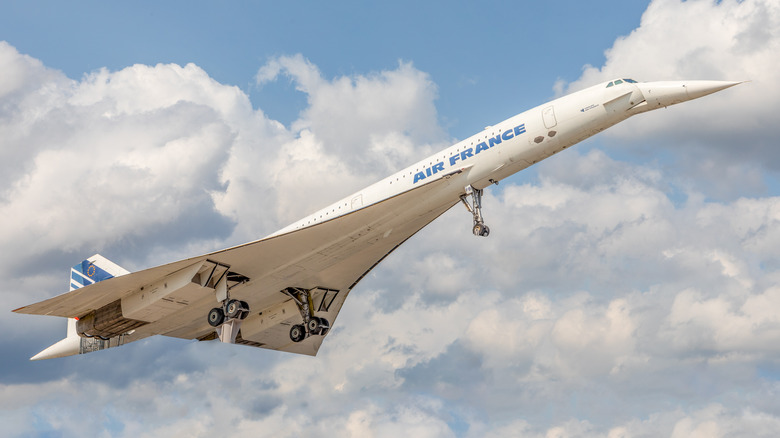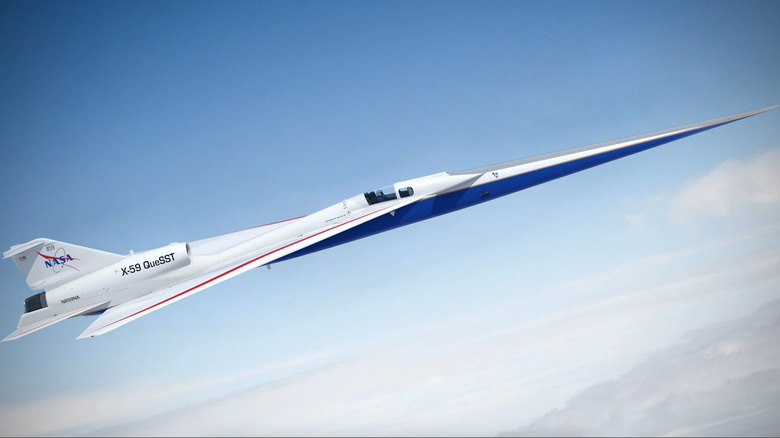
Travelview/Getty Images
Supersonic commercial flights are on the road to making a comeback, decades after the Concorde took to the skies and then witnessed a spectacular fall that was a mix of commercial as well as technical failures. Earlier this month, NASA lifted the covers from the X-59, a supersonic one-of-a-kind experimental aircraft. Developed in collaboration with Lockheed Martin, the «quiet» X-59 could pave the way for, as they describe it, «a new generation of commercial aircraft that can travel faster than the speed of sound.»
It’s a promising development coming from two engineering titans in their respective fields, raising hopes that commercial supersonic flight could make a real comeback, riding high on the heels of commercial space jaunts championed by the likes of SpaceX and Blue Origin. NASA won’t be the only player in the segment. Boom Supersonic, a private company based in Colorado is also on track to conduct the first test of its XB-1 aircraft which is said to travel at twice the speed of current passenger planes. Assuming the tests are successful, the tech will make its way to the Overture, an all-business-class supersonic passenger aircraft.
We asked Richard Levy about the future of supersonic aircraft — are NASA and Boom Supersonic’s plans viable? «Successful test results from NASA and/or Boom Supersonic could be all that is needed for the FAA to release restrictions on future commercial airline flights to anywhere in the world,» said Levy.
Levy is a retired airline Captain of 41 years with a major international airline. He also flew for 8 years in the United States Air Force flying the C-130 aircraft. He currently is a simulator instructor at another major airline and provides Expert Consulting services to attorneys involved in aviation litigation.
A noisy problem

Lockheed Martin
Risks associated with fuel inefficiency (especially regarding range and fuel reserve protocols), fuel tank fire hazard potential, the danger associated with high altitude decompression, temperature shear, and environmental red flags were some of the biggest hurdles in the way of Concorde’s US FAA nod. Then there was the noise issue, which was unavoidable every time the Concorde breached the sound barrier. Environmental impact assessment demonstrated that during landing, the Concorde was marginally quieter than a Boeing 707, but during take-off, it was twice as noisy as a Boeing 707, four times noisier than a Boeing 747, and eight times louder than a DC-10.
«An aircraft flies supersonically at roughly 765 miles per hour. Depending upon factors, such as outside air temperature and altitude flown, airflow around the nose and wings of the aircraft cannot get out of the way; therefore, a «shock» or «sonic boom» is created,» Levy explains.
Exposure to aircraft-borne noise pollution has already been linked with disruptions in sleep, delays in children’s learning, issues with mental health, and cardiovascular diseases. The sonic boom generated by commercial supersonic airplanes could prove to be worse.
NASA assures that the X-59 only produces what it calls a «quieter sonic thump.» NASA test documents show that this thump would be roughly equivalent to the noise made by a car door slamming shut 100 feet down the road.
Boom Supersonic is also trying to allay noise concerns, noting that the sound produced by the Overture will be comparable to the current fleet of subsonic aircraft. The company notes that, unlike the Concorde, the Overture will not use afterburners, and its jet exhaust will remain subsonic during take-off. Consequently, there will be no intense shocks in its exhaust plume, often observed and heard in supersonic military aircraft.
Fuel cost dynamics
One of the biggest reasons that the Concorde’s business endeavors failed was the high fuel burnout, which not only made the supersonic flights exclusive to rich clients but also led to a business model failure in the long run. Flying at supersonic speed requires more propulsion energy, and owing to the different flight conditions compared to an average airplane, the fuel consumption for a given distance is also higher.
A detailed analysis paper from Boom Supersonic (PDF) that came out in 2022 and built atop flight data provided by the U.S. Department of Transportation, already admits that the Overture’s supersonic flights will guzzle 2-3 times as much fuel as an average premium class trip, further noting that the consumption intensity is roughly 2.5 times lower. The gap is not small, and that will almost certainly add up to the costs. «Prices could be higher due to higher fuel expenses,» Levy notes.
For now, Boom appears on the safer side, at least from a financial perspective. The company says it has secured orders with non-refundable deposits from multiple big names. According to Boom press release, «Overture’s order book, including purchases and options from American Airlines, United Airlines, and Japan Airlines stands at 130 aircraft.» Additionally, it has secured commercial partnerships with the likes of Northrop Grumman seeking government and defense-related deployment for the Overture technology, but that could change.
«Like a conventional order for the current generation of aircraft from Boeing or Airbus though, orders can be canceled, if ‘the numbers’ do not add up,» says Levy. The situation could also sway if Boom’s test flights don’t live up to the company’s claims and regulators once again get a bad feel about greenlighting commercial supersonic flights.
Cost may not be a problem
One of the reasons cited for Concorde’s failures was high ticket prices and even higher maintenance costs. The former may not be much of a problem. As far as Boom goes, ticket prices could be anywhere between $2,500, as per The Washington Post, while Quartz report notes that a London-New York return flight could cost around $5,000. Adjusted for inflation, British Airways used to charge much higher for its Concorde flight seats. An average New York-London round-trip flight cost $7,574 via British Airways in 1996, per Encyclopaedia Britannica. That translates to $15,047, adjusted for inflation as of December 2023 standards, according to the U.S. government’s CPI Inflation Calculator.
Notably, it was not as much as the cost of tickets that proved to be a problem for Concorde, but the rising fuel and maintenance charges. John Hutchison, who led Concorde flights for nearly fifteen years, said the price of tickets was not a concern for British Airways, one of the two major Concorde fleet owners. «Ticket costs were not a factor, recalls Hutchinson. In the late 1980s BA conducted surveys of regular passengers, asking how much they paid. And people hadn’t a clue, their PAs booked the tickets. So they’d say «I don’t know, £4000, £5000?» and BA would average it out and that’s what they’d charge. It was a fantastic money-maker,» Hutchinson was quoted as saying by National Geographic.
In 2024, the situation is significantly better for companies trying to embrace commercial supersonic flights, because the base of affluent passengers capable of affording tickets has gone up dramatically. According to Forbes, the number of billionaires has tripled in the past decade that began in 2010, with more than 200 new billionaires popping up in the United States alone in that window. In just over two decades, the number of millionaires in the country has tripled, crossing the 22 million mark as of 2022, according to the UBS Global Wealth Report data.
The flight conundrum
One of the biggest challenges that stand in the way of supersonic vehicles taking to the skies again is regulatory clearance. As Levy asks, «Where are you going to fly an airplane supersonically? What altitude do you propose to fly in? What type of aircraft? Where is your data showing evidence of reduced noise levels after exceeding the speed of sound (MACH 1)?»
Fuel efficiency, as mentioned above is already a headache, but Boom also leaning more on external scientific research to explore the real environmental impact of supersonic flights.
To its credit, Boom Supersonic says is going to use 100% sustainable aviation fuel (SAF), which is derived from renewable sources such as algae, waste oil, and plant residue. The company hopes to achieve a net zero carbon footprint as early as next year and hopes to achieve net zero greenhouse emissions by 2040. NASA, on the other hand, has set a target of net zero carbon emissions by 2050. Notably, NASA’s X-59 project could be a sign of good times for Boom Supersonic, at least from a regulatory clearance perspective.
The federal government enforced a ban on civilian supersonic flights over land back in 1973, primarily because of the sonic boom issues. As part of the Quesst project’s efforts to gauge public perception regarding this noise, the plan involves conducting flights of the X-59 over various communities to assess people’s reactions. Subsequently, NASA will share the findings with both U.S. and international regulatory authorities, prompting them to contemplate the implementation of new regulations that could potentially overturn the long-standing ban. NASA’s test flight is scheduled for 2028, and pending validation, a commercial aircraft will be assembled in the 2030s.